




Your support is critical to our success.
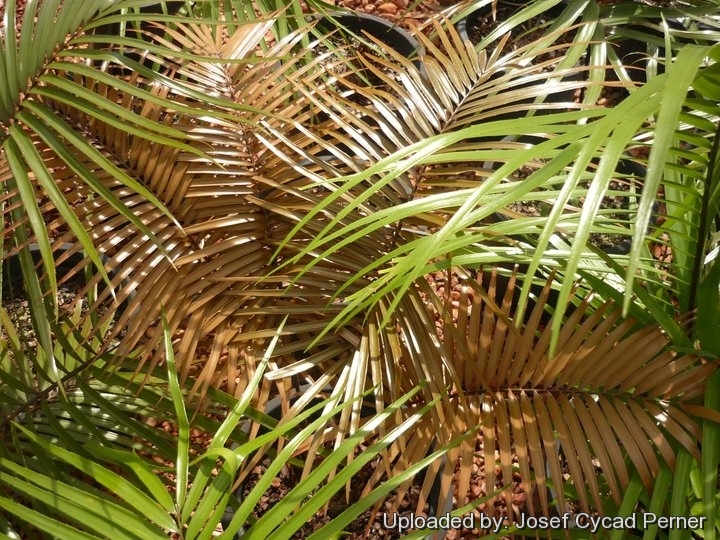
Bronze and Green emergent types.
Origin and Habitat: Zamia standleyi is found in the northern river valleys of Honduras (Colon, Atlantida, Yoro and Cortez provinces), from San Pedro Sula eastward toward the Caribbean coast, reported as far east as the Rio Platano. Further fieldwork is necessary to determine the full extent of the range of the species and whether it extends into contiguous areas in Guatemala. This species is estimated to comprise approximately 5,000 plants in the wild. It appears most closely allied to Zamia splendens native to Chiapas, Mexico, Zamia purpurea from Veracruz and Oaxaca, Mexico,and Zamia cremnophila, a cliffdwelling, pendent-leaved species from Tabasco, Mexico.
Altitude range: This species is found from sea level to 200 metres.
Habitat and Ecology: This species is found along the valleys of the northern rivers from moist hillsides, seasonally dry woodlands, disturbed secondary scrub (matorral), areas of regrowth and even on the edges of gardens and fields. They prefers a place under established canopy.
Synonyms:
- Zamia standleyi Schutzman
SPANISH (Español): camotillo, yuca de ratón
Description: Zamia standleyiSN|31953]]SN|31953]] is a small to medium sized, under-story species with feathery arcuate fronds that resemble palms. Its subterranean caudex can get to a bit over 10 cm in diameter, leaves are up to 100 cm long and about 60 cm wide, and leaf colour is glossy green. Newly emerging leaves may be green or bronze-red and they can also be a white fluffy velvet look. The plant is quite attractive, especially the red-leaved individuals, which keep their emergent colouration for quite some time. Leaflets are finely toothed but not overly armed. Zamias are dioecious, meaning that there are separate male and female plants, and the female produces seeds while the male produces pollen. The female cones are held nearly erect while male cones are reclined on the ground but with ascending apex. The latter are thinner and smaller in size than the female cones.
Distinguishing characteristics: Zamia standleyiSN|31953]]SN|31953]] is a very distinctive cycads with arcuate leaves and marked sexual dimorphism in cone habit that set it apart from other species in the genus. The leaflets are linear to oblong-lanceolate, falcate to subfalcate with extremely spinulose marginal teeth. Rachis without prickles. Zamia standleyiSN|31953]]SN|31953]] is the only species in the genus in which the leaflets have a slight fod paralleleling their long axis.
Derivation of specific name: The species is named for botanist Paul C. Standley.
Stem (rootstock or caudex): Subterranean, tuberous, subglobose to turnip-shaped, up to 12 cm in diameter, continuous with a variously carrot-shaped root (or roots). Maturing plants of Z. vazquezii often develop multiple trunks.
Leaves (fronds): Few (usually 1-5 depending on age, location, and condition of the plant) 0.2-1 m long, slightly to strongly arcuate, white tomentulose red or bright green when expanding later all glossy green. Leaflets 10-15 pairs, simple, coriaceous, linear to oblong-lanceolate, opposite to subopposite, 20-45 cm long, 1.5-3.5 cm wide; apex acute. Margin toothed, parltly folded, marginal teeth finely spiny, 0.5-4.0 mm long. Petiole more or less spiny, especially closer to the petiole base, 10-55 cm long, spines straight, to 5 mm long; petiole base bulbous in larger leaves. Rachis without prickles.
Cataphylls: The cataphylls (Modified leaf, much reduced and thickened, serving to protect the apical meristem in cycads produced in flushes preceding the emergence of cones or leaves.) are chartaceous, elongate triangular, those preceding cone formation with a long twisted acuminate apex, without stipules, 5-11 cm long, 0.9-1.5 cm wide; cataphylls preceding leaf formation triangular, stipulate, 3.5-5 cm long, 1.4-2.6 cm wide.
Male cones: Cylindrical, pedunculate, declinate to decumbent, coffee-coloured, 7-8 cm long, 1.5-2 cm across; microsporophylls cuneiform, hexagonal-truncate. Pollen-sacs spheroidal, (14)16(18) per sporophyll, dehiscing by longitudinal sutures. Peduncle puberulent, 2-4 cm long.
Female cones: Cuneiform, the distal ends hexagonal-truncate with a short hexagonal-truncate protuberance. Ovules two per megasporophyll.
Seed: 1.6 cm long, 1.0 cm wide, sarcotesta salmon pink turning bright scarlet at maturity.
Chromosome number: 2n = 16.
Bibliography: Major references and further lectures
1) Stevenson, D.W. 2010. Zamia standleyi. The IUCN Red List of Threatened Species 2010: e.T42157A10670216. http://dx.doi.org/10.2305/IUCN.UK.2010-3.RLTS.T42157A10670216.en . Downloaded on 11 October 2015.
2) V.P. Singh “Gymnosperm (naked seeds plant) : structure and development” Sarup & Sons, 01 January 2006
3) Andrew P. Vovides, Dennis William Stevenson, Roy Osborne “Ecología, A.C., Xalapa, Veracruz, Mexico” New York Botanical Garden Press, 01 January 2007
4) Bart Schutzman “A New Species of Zamia from Honduras” Systematn- Botany , 14(2) pp 214-219 1989.
5) Phil Bergman Jungle Music Palms and Cycads 06/23/2014 "ZAMIA, AN INTRODUCTION TO THIS GENUS OF VERY EXOTIC CYCADS" <http://www.junglemusic.net/Zamia/Zamia_An_Exotic_Type_Of_Cycad.html> Web. 11 October 2015.
6) Wikipedia contributors. "Zamia standleyi." Wikipedia, The Free Encyclopedia. Wikipedia, The Free Encyclopedia, 18 Jan. 2014. Web. 11 Oct. 2015.
7) PACSOA contributors “Zamia standleyi”. In: Cycads. Palm and Cycad Societies of Australia (PACSOA). <http://www.pacsoa.org.au/wiki/Zamia_standleyi> 25 November 2013 Web. 28 August 2015.
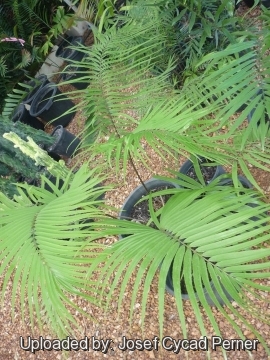
Zamia standleyi Photo by: Josef Cycad Perner

Zamia standleyi Photo by: Josef Cycad Perner
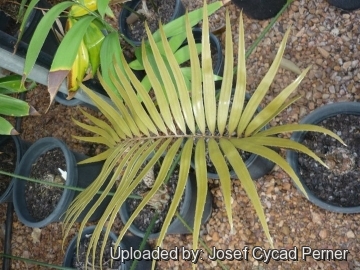
Zamia standleyi Photo by: Josef Cycad Perner
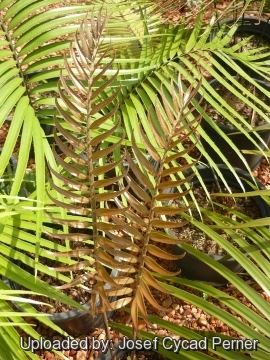
Zamia standleyi Photo by: Josef Cycad Perner
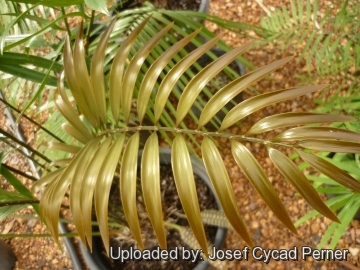
Zamia standleyi Photo by: Josef Cycad Perner
The gallery now contains thousands of pictures, however it is possible to do even more. We are, of course, seeking photos of species not yet shown in the gallery but not only that, we are also looking for better pictures than those already present. Read More...
Cultivation and Propagation: Zamia standleyiSN|31953]]SN|31953]] is a good versatile cycad for smaller gardens that prefers filtered light or shade, warmth, humidity and good soil drainage. It is easy to grow in tropical and subtropical regions. Has a subterranean stem, but in cultivation, stem is usually exposed a bit for looks. This plant would make a rather nice house plant in temperate countries. This is a very exotic appearing plant much sought after by collectors.
Growth rate: This species is rather fast and in good conditions can speed it up considerably and could go from seed to coning size plants in a few years.
Exposition: It prefers filtered sunlight to partial shade; best with some protection from afternoon heat but not in constant deep shade. Generally speaking the plants that are in a situation under shrubs are more vigorous.
Soil: Needs a well drained sandy or sandy loam spot, with deep soil, neutral or basic (tolerate limestone) but will still thrive in less than ideal conditions. Mulch with organic materials (bark or leaf mould).
Moisture: Water when dry.
Fertilization. Because of its growth habit, fertilize only when terminal bud begins to swell, indicating the start of the annual growth cycle.
Hardiness: It should be protected from extreme cold. (USDA Zones 9-11) Cold hardiness is down to about a freeze. Sustains leaf damage at -0° C.
Salt aerosol tolerance: It is salt resistant and is even happy living out on seaside condominium balconies.
Maintenance: Minimal; removal of offsets if desired, removal of spent fronds
Use: Landscape as cultivated perennial in warm, coastal areas, it makes a great accent or specimen plant and can be used in beachside plantings. Several can be planted together for a lush, tropical effect. Plant on three to five-foot-centers to create a mass planting. Use near the patio, in mixed foundation plantings or in perennial beds. It is a spectacular house-plant or interior-scape specimen in cool areas tough enough to survive occasional neglect and harsh indoor environments. It is very well suited to bonsai culture.
Warning: This plant is poisonous, producing a toxin called cycasin that affects the gastrointestinal tract and nervous system. Itis known in Honduras as “yuca de ratón”, meaning mouse manioc and referring to their use as a rodenticide. The allusion is to Manihot esculenta Crantz (Euphorbiaceae), a poisonous tuber with high starchy ontent made edible through a process similar to that used for zamias. The Pech indigenous group call Z. standleyi, yojni unicej (“venomous yuca”). Its root is highly poisonous, and has been employed at times for criminal poisonings, as well as for poisoning noxious animals. There is a popular belief that the root, if out of the ground two days, kills its human victim in two days; if dug in a week, it kills in a week, and so on. Poisonous Parts: Fleshy seeds, stems, roots, leaves. Protect pets and instruct children to never eat or chew any plant material without permission.
Propagation: Seeds. The germination process is slow and difficult to achieve in cultivation, after fertile seeds are collected, they usually need several months of storage before the inner embryo is ready to germinate. Therefore, it is best to clean the seeds of external fruit and set them aside before attempting to propagate the seeds. Seeds should be sown in shallow container, lightly covered with sand, and after germination, potted off in small pots of moderately rich, light soil. The growing plants do best in partial shade. The old plants frequently send up suckers around the base of the trunk. These may be taken off when in a dormant state and rooted, care being taken to remove the leaves to guard against excessive transpiration. The advantage of the "pups" is that you will know its sex, for seedlings you will have to wait several years until the plant flowers to find out.
| Your Actions | |
|---|---|
| Back to Zamia index | |
| Back to Zamiaceae index | |
 |
Back to Palms And Cycads Encyclopedia index |
Privacy stantement - Terms and conditions - How to cite - About us - Feedback - Donate


